Grapes - a culture of the south, not adapted for cultivation in regions with a harsh climate. Thanks to the selection and painstaking work of gardeners, varieties capable of tolerating frosts were obtained. At the end of the last century, the range included mainly technical types suitable for winemaking. The situation is changing, frost-resistant table varieties have appeared, which are distinguished by a tender juicy berry, excellent taste characteristics. Subject to agricultural technology high crops are harvested even in the North-West, in Siberia, and in the regions of the Urals.
Content
- 1 The concept of frost resistance of culture
- 2 The benefits of frost-resistant grape varieties
- 3 Frost resistant varieties
- 3.1 Alpha
- 3.2 One or the Amur breakthrough
- 3.3 Crystal
- 3.4 Riddle of Sharov
- 3.5 Skuin 675 or Moscow steady
- 3.6 White Muscat (Shatilova)
- 3.7 Ataman
- 3.8 Ilya
- 3.9 Cherry
- 3.10 In memory of Smolnikov
- 3.11 Citron Magaracha
- 3.12 Julian
- 3.13 Galahad
- 3.14 Taiga
- 3.15 Blue north
- 3.16 Muromets
- 3.17 Pink pearls
- 3.18 Muscat Russian
- 3.19 Kishmish Niagara
- 3.20 Jisper Jigsaw
- 3.21 Sultana Venus
- 3.22 Kishmish Spartan
- 3.23 Louise Swanson
- 3.24 Marquette
- 3.25 Frontignac
- 3.26 Adalmina
- 4 Features of the cultivation of non-covering varieties
- 5 Highly resistant non-covering hybrids
- 6 The most frost-resistant for arbors and arches
- 7 Reviews
The concept of frost resistance of culture
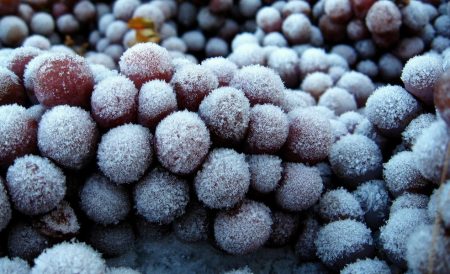 The ability of a plant to tolerate critical negative temperatures is called frost resistance. The characteristic should be distinguished from winter hardiness - the resistance of a particular variety to a combination of adverse factors that occur in the winter season. Factors include resistance to subzero temperatures.
The ability of a plant to tolerate critical negative temperatures is called frost resistance. The characteristic should be distinguished from winter hardiness - the resistance of a particular variety to a combination of adverse factors that occur in the winter season. Factors include resistance to subzero temperatures.
Cultural vulnerability - kidneys, the first to freeze with a sharp decrease in temperature. Further, the bark and wood of the shoots are damaged. When describing the species, the degree of resistance to frost, derived from long-term observations and testing, is indicated. But when growing on the site, it may turn out that the declared indicator does not correspond to the result obtained and this should be taken into account.
The absolute minimum critical temperature for grapes is -23ºC ... -24ºC (increased frost resistance). With a significant decrease, from 50 to 80% of the kidneys freezes out, without damage to the bark and wood, the bush, with proper care, will survive.
The benefits of frost-resistant grape varieties
Species included in this group are grown in Russian regions belonging to territories with severe climatic conditions. The main advantage is the expansion of the area of culture cultivation.
Also advantages include:
- the opportunity to do without shelter for the winter;
- high productivity;
- unpretentiousness;
- density of berries and brushes, which allows transporting products over long distances.
Varieties are mostly technical, suitable for making wines.
Frost resistant varieties
The degree of resistance to subzero temperatures in the grapes of the group varies. Plants that withstand temperatures up to -27ºC need to be covered; more hardy ones do not need shelters.
Alpha
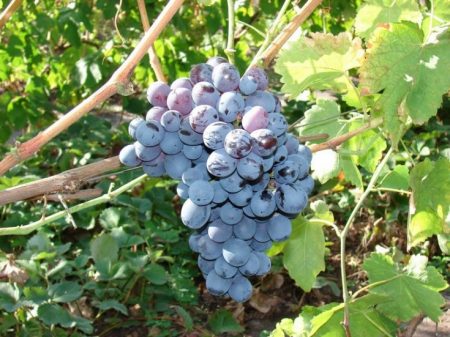 Viable, unpretentious. It was brought to the USSR from the USA, zoned for the Primorsky Territory. Perfectly adapted in the Far East, cultivated by winegrowers of southern Siberia, the Urals, the middle zone.
Viable, unpretentious. It was brought to the USSR from the USA, zoned for the Primorsky Territory. Perfectly adapted in the Far East, cultivated by winegrowers of southern Siberia, the Urals, the middle zone.
Great growth force, the vine is standardized for a high yield. There are many grons, 120 grams is the average weight. The berries are small, black with a reddish tint from one side. The taste is mediocre, the aroma of strawberries is felt. Appointment - preparation of wine, tinctures.
Bushes are used to frame arbors (large formation). Berries ripen in 140-145 days.They do not crumble on bushes, they are not prone to cracking.
Alpha berries are harvested after the first frost, when sugar levels rise in them.
One or the Amur breakthrough
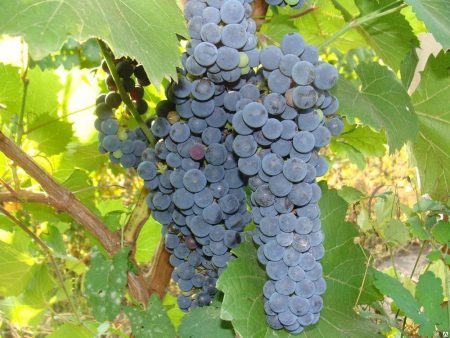 It is found in catalogs under various names - Odin, Potapenko-7. Authorship belongs to A.I. Potapenko - a well-known breeder working on the cultivation of frost-resistant species of grapes.
It is found in catalogs under various names - Odin, Potapenko-7. Authorship belongs to A.I. Potapenko - a well-known breeder working on the cultivation of frost-resistant species of grapes.
A thick-growing bush, young shoots are green, then, as they grow older, the color changes to a reddish, brown one. Grapes in 3-4 grams, pink, purple, pleasant taste. Sugar level - 23% (high).
Withstands frosts down to -40ºC. Needs abundant watering, with drought, productivity drops sharply. On average, 9-10 kg are removed from the bush.
Crystal
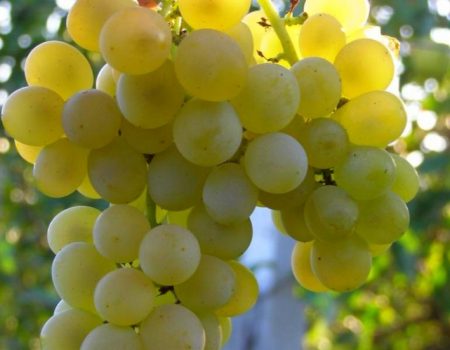 The unpretentious appearance of clusters on the vine is compensated by the excellent taste and frost resistance of grapes. The berries ripen early, in mid-August they begin to harvest. Small size and weight of the fruit juicy, sweet. The color is whitish green, amber in the sun.
The unpretentious appearance of clusters on the vine is compensated by the excellent taste and frost resistance of grapes. The berries ripen early, in mid-August they begin to harvest. Small size and weight of the fruit juicy, sweet. The color is whitish green, amber in the sun.
Gronov loose, 180-200 grams.
Bushes of medium size, with smooth small leaves. Variety feature: rapid shoot growth, varying degrees of leaf dissection.
Grown in the Caucasus, in the middle zone of the Russian Federation (without shelters). In the regions of Siberia and the Urals - only with shelter for the winter.
Riddle of Sharov
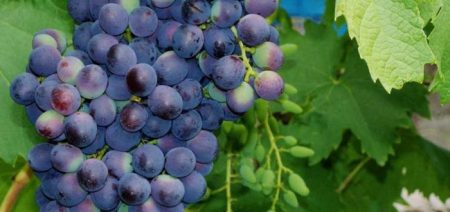 A parent pair of this species is a crossed Far Eastern hybrid and European varieties Tukay, Magarach.
A parent pair of this species is a crossed Far Eastern hybrid and European varieties Tukay, Magarach.
Gives winged friable clusters, 400-600 grams. Rounded berries expire in juice, sugar content 21%. Valued among winegrowers for their sweetness, aroma (raspberry, strawberry notes).
Berries 2-3 grams, blue with saturated spring. In the pulp - a pair of small seeds.
From adult bushes remove 10-12 kg of fruit. Most of the regions of Russia are grown without shelter. Frosts are not terrible to - 34ºC. Berries are suitable for storage (2.5-3 months), there is no loss of taste.
Skuin 675 or Moscow steady
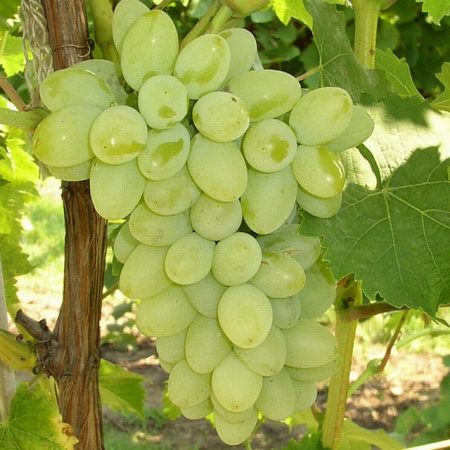 It is not used in industrial plantings, it is popular with amateur winegrowers. Bred in the Moscow region (hence the name), breeder K.P. Skukinem.
It is not used in industrial plantings, it is popular with amateur winegrowers. Bred in the Moscow region (hence the name), breeder K.P. Skukinem.
Used for making wine, sugar content 21-22%. Unpretentious, in the middle lane requires minimal shelter for the winter. Berries ripen from the end of August.
Loose brushes, 80-100 grams, small berries, beautiful amber color. The taste of grapes is interesting - pronounced muscat with notes of pineapple. To increase productivity, the shoots are standardized. Distributed in Minnesota (USA), where it is cultivated for the production of wines.
White Muscat (Shatilova)
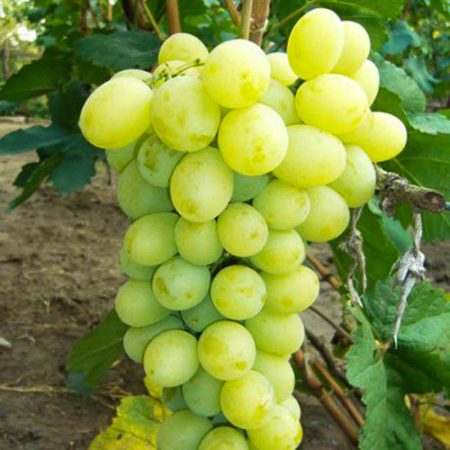 Vigorous hybrid, the name was obtained in honor of the author - breeder F. I. Shatilov (Orenburg). It has a good yield (10-12 kg), unpretentiousness.
Vigorous hybrid, the name was obtained in honor of the author - breeder F. I. Shatilov (Orenburg). It has a good yield (10-12 kg), unpretentiousness.
Ripens in mid-August (middle band), accumulating a large amount of sugars. Grapes 5-6 grams, white with a characteristic amber tint. The brush is broad-conical, massive, up to 1.5 kg.
Not afraid of the main diseases of the culture, resistant to long-term cold snap, frosts up to 27ºC are not terrible. Feature: strong growth, large leaves.
In Siberia and the Urals, it grows and bears fruit well, but it is recommended to shelter for the winter.
Ataman
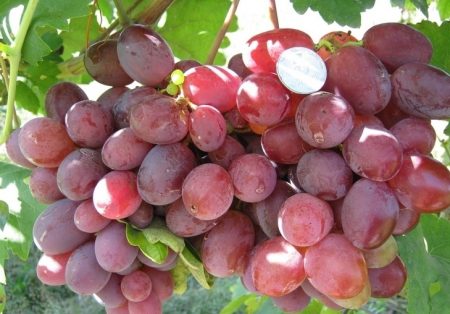 This frost-resistant (-24ºC) grape is cultivated mainly in the southern regions. The reason is the late harvest of berries (145-150 days), the need for a long summer season.
This frost-resistant (-24ºC) grape is cultivated mainly in the southern regions. The reason is the late harvest of berries (145-150 days), the need for a long summer season.
The plant is powerful, more than 50% of the shoots are fruit-bearing. Appreciated for productivity, excellent taste. Grons form, otherwise there is a risk of not ripening berries, reducing their number.
Grapes 15-18 grams, dark red, with a bright purple tint. Bunches on average 800 grams, individual specimens - 1.8-2 kg. The acid content is 7-8, sugar - 20%. Included in the table grape group, the taste is pleasant.
Ilya
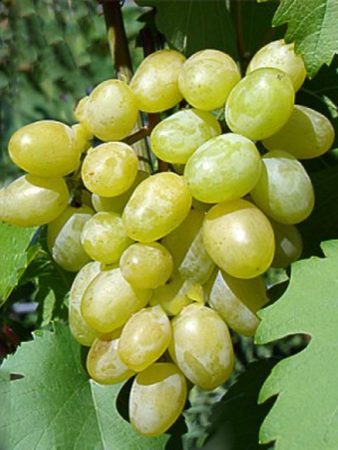 Berry picking - after 110 days, therefore, refers to the early types of culture. Recently appeared in nurseries, the parent pair - Wax and Kishmish radiant.
Berry picking - after 110 days, therefore, refers to the early types of culture. Recently appeared in nurseries, the parent pair - Wax and Kishmish radiant.
It will please you with loose large clusters (600-1000 grams).Juicy, tasty berries grow up to 14-20 grams. Sugar - 22%, low acidity, about 6 g / l.
Great variety for dessertshas good marketability. For a set of sugar content, winegrowers withstand berries on the shoots for 8-10 days after full ripening.
Cherry
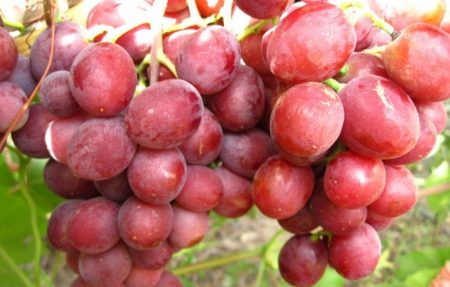 Few susceptible to disease, bears fruit in adverse weather conditions. The hybrid form was developed by E.G. Pavlovsky. The species is successfully grown in regions of Russia with different climates.
Few susceptible to disease, bears fruit in adverse weather conditions. The hybrid form was developed by E.G. Pavlovsky. The species is successfully grown in regions of Russia with different climates.
Bushes average in height give clusters of 400-500 grams. The grapes are oval, the color is dark burgundy. The flesh melts in the mouth, with a pleasant, slightly musky taste. The shell is dense, it is not felt when eating.
Praise the form for resistance to subzero temperatures (-25ºC), sweetness of berries (18% sugar). Harvesting - the beginning of August (south), in the middle lane - the end of summer.
In memory of Smolnikov
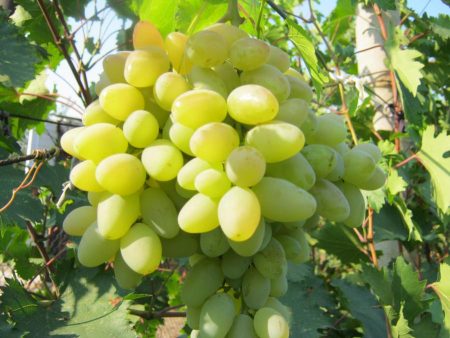 The new hybrid, featuring beautiful massive brushes on the vine. Delicious, mid-season and sweet grapes do not deteriorate for a long time after harvesting, suitable for transportation over long distances.
The new hybrid, featuring beautiful massive brushes on the vine. Delicious, mid-season and sweet grapes do not deteriorate for a long time after harvesting, suitable for transportation over long distances.
Table view, clusters - 800-17000 grams, berries - 15-16 grams. Original shape in the form of a nipple. Color varies from green-white to pinkish.
Shoots ripen well, inherent in overload. Rationing is required, otherwise there will be losses in productivity. It tolerates frosts of -24ºC, it matures in regions with short summers and harsh winters, but mandatory shelter is required. In the middle lane, a number of wine growers grow without protection for the winter.
Citron Magaracha
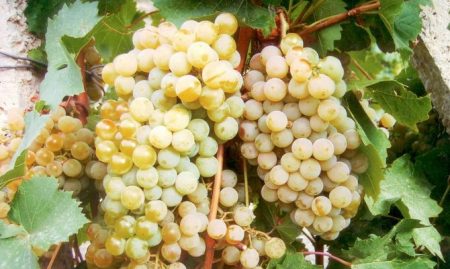 It is declared as a variety with a fairly high resistance to frost (-25ºC), but is recommended for the southern regions. Berries of 5-6 grams, sweet, with a touch of citrus, nutmeg.
It is declared as a variety with a fairly high resistance to frost (-25ºC), but is recommended for the southern regions. Berries of 5-6 grams, sweet, with a touch of citrus, nutmeg.
The main purpose is the manufacture of nutmeg, dessert wines, champagne. Lovers make homemade wine, juice. They start cleaning in 130-140 days.
Resistant to disease damage, successfully resists winged aphids. Prevention is required, for winter shoots are cut off, sheltered according to traditional technology.
Julian
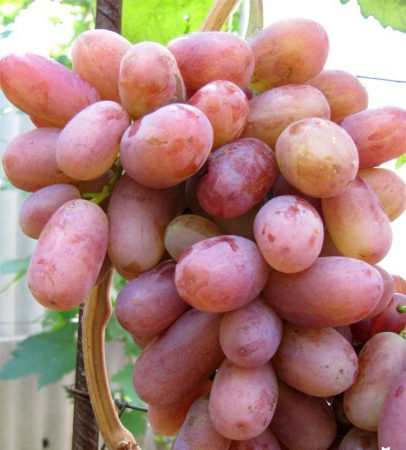 The homeland of the variety is Rostov Region, the growing regions are in the south of Russia. It is positioned as a species resistant to subzero temperatures, but landing in the middle lane and northern regions is not practiced.
The homeland of the variety is Rostov Region, the growing regions are in the south of Russia. It is positioned as a species resistant to subzero temperatures, but landing in the middle lane and northern regions is not practiced.
Very early (95-100 days), with tasty, “finger-like” berries. Painted in pinkish with yellow tints, 18-20 grams. The grones are massive, 800-1000 grams (average). With proper care and proper rationing, they get a bunch of up to 2 kg.
It is famous for its excellent taste - bright, sweet, with pronounced notes of muscat. Excellent marketability, suitability for transportation, keeping quality - all this makes Juliana a suitable grape for growing for sale.
Galahad
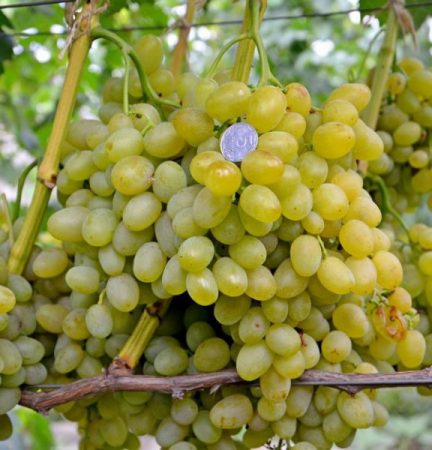 Promising, successfully proven during cultivation in the middle lane. In the climate of the Urals and Siberia, cultivation is required only in well-lit areas, in greenhouses.
Promising, successfully proven during cultivation in the middle lane. In the climate of the Urals and Siberia, cultivation is required only in well-lit areas, in greenhouses.
It provides excellent berry pick-up, tolerates a drop in temperature to -25ºC. It is steady against diseases, berries do not crack. When transporting clusters, grapes, combs do not deteriorate.
Ripe berries fall from the vine. A timely harvest is required.
Grapes are harvested in clusters, 600-1100 grams. The berries are elongated, yellowish, with an overflow of color. Sweet, without sugary, sugar content 19-21%. Valued for productivity (ripening 70-80% of the vine), unpretentiousness.
Taiga
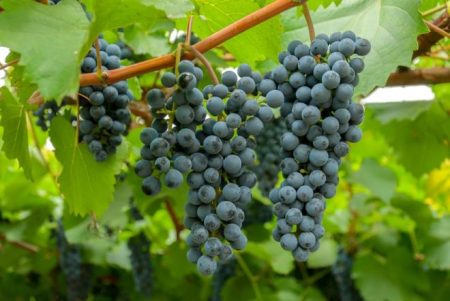 Over-ripening and the ability to tolerate frosts down to -30ºC are the reasons for the popularity of a non-breeding variety. The berries are simple in taste, contain up to 20% sugars and a large amount of pectin.
Over-ripening and the ability to tolerate frosts down to -30ºC are the reasons for the popularity of a non-breeding variety. The berries are simple in taste, contain up to 20% sugars and a large amount of pectin.
The clusters are loose, 200-250 grams, round grapes are painted in dark blue, sometimes almost black. Suitable for making wine, desserts, juice.
Taiga "came" to the middle lane from Primorye, where it grows in the wild. A cultivated look has taken root in areas of gardeners in the Moscow Region, in the Northwest. Appreciated for productivity, low susceptibility to diseases.
Blue north
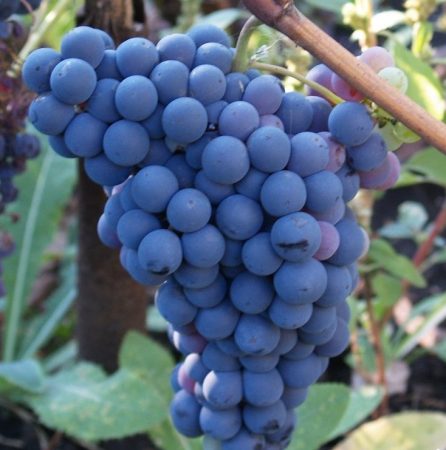 Winters on trellises (Moscow region), in Siberia, in the Urals it is recommended to cover.
Winters on trellises (Moscow region), in Siberia, in the Urals it is recommended to cover.
Small, sweet berries ripen in late August. Small brushes, dense structure. Advantages:
- cold in minus 40ºC is not terrible;
- stable yield;
- pleasant taste of grapes;
- universality of use.
It is advisable to form bushes by removing extra clusters from the shoots for better ripening of the rest.
Muromets
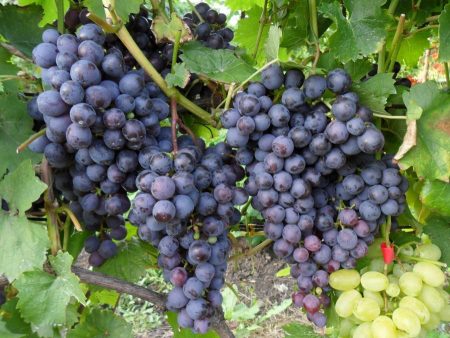 Like its epic namesake, the variety shows remarkable strength, transferring frosts to minus 26ºC. Among table grapes there are few cold-resistant species, moreover, Muromets is distinguished by its early ripening.
Like its epic namesake, the variety shows remarkable strength, transferring frosts to minus 26ºC. Among table grapes there are few cold-resistant species, moreover, Muromets is distinguished by its early ripening.
High yields are harvested in the suburbs, in the Urals. It is famous for its rich taste, sweetness (sugar - 20%). Grones are standard, conical, medium density, 500-600 grams. Berries 5-6 grams, purple with a light spring.
Gardeners collect 10-12 kg per bush, subject to proper care. Berries from tasters received a good mark.
Disadvantages:
- possible peeling;
- highly susceptible to wasp attacks;
- cracking (manifested by heavy rainfall).
It is medium resistant to culture infections.
Pink pearls
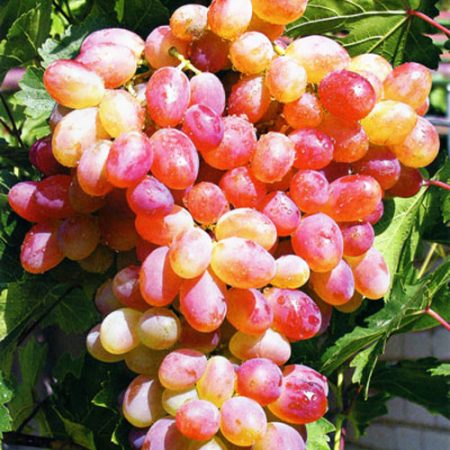 Winters on trellises without shelters when lowered to minus 18ºC, requires shelter, but withstands frost -30ºC well.
Winters on trellises without shelters when lowered to minus 18ºC, requires shelter, but withstands frost -30ºC well.
Promising, although not presentable externally grapes. The fruits are similar to pearls, lilac-pink color. Stacked tight grones 400-500 g, conical.
They note the taste - sweet (sugar 24%), pleasant. Advantage: early harvest (end of summer), unpretentiousness, versatility of use. Well suited for juices, wine making, excellent fresh. "Minus": not suitable for transportation.
Muscat Russian
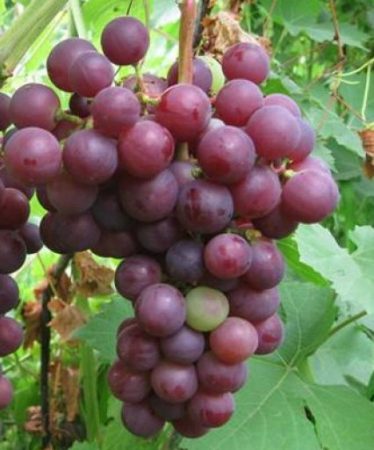 Bred in Russia, characterized by dense lobed brushes (300 g), rounded grapes of a pleasant taste. Harvest increases significantly with proper irrigation of plantings.
Bred in Russia, characterized by dense lobed brushes (300 g), rounded grapes of a pleasant taste. Harvest increases significantly with proper irrigation of plantings.
Bushes of medium strength, leaves are strongly dissected.
Harvest is ready for harvest in 115 days (southern regions). High resistance to most diseases. The purpose is universal, excellent fruit is obtained from the fruits.
Kishmish Niagara
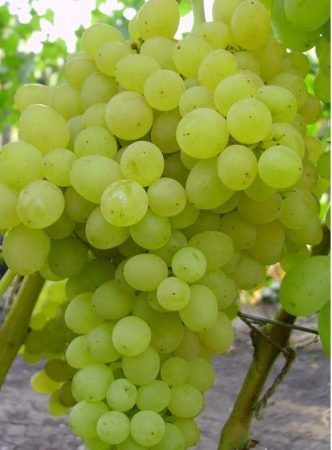 Dense clusters hang in a cascade from the vine, hence the poetic name - Niagara. Bred in the USA, American hybrid subspecies served as parental pairs. Sweet fruits of 4-5 grams are collected in dense beautiful grones (600-800 grams)
Dense clusters hang in a cascade from the vine, hence the poetic name - Niagara. Bred in the USA, American hybrid subspecies served as parental pairs. Sweet fruits of 4-5 grams are collected in dense beautiful grones (600-800 grams)
Individual brushes reach 1 kg.
It is famous for its taste, rapid ripening (100 days), good yield. Of the rafts for regions with a harsh climate, Niagara is one of the most popular species.
Jisper Jigsaw
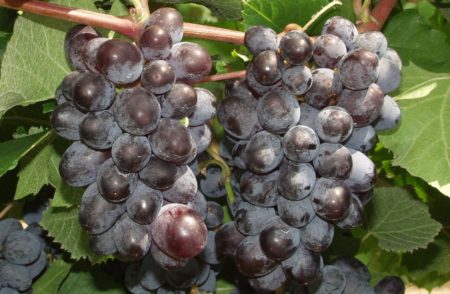 It will survive the winter with colds up to -27ºC, it ripens early, after 115 days they are harvested. Aging on shoots up to 95%.
It will survive the winter with colds up to -27ºC, it ripens early, after 115 days they are harvested. Aging on shoots up to 95%.
Brushes are formed from large grapes with a dense skin. The color is dark blue, the flesh is refreshing, pleasant. A little acid, 5g / l, sugar 21%. The aromatic taste of nutmeg is felt. Notes are stronger when overexposed crops on the bushes.
In the heat, the fruits are colored faster than the ripening of the pulp.
Sultana Venus
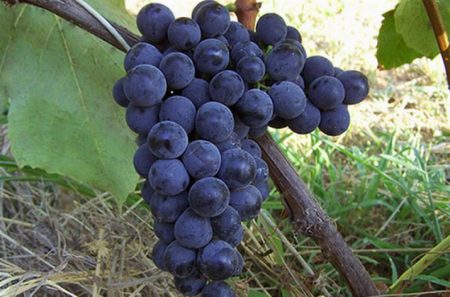 It is used as a fruit-bearing culture, as well as for the decorative design of arbors, arches. Grapes ripen early, harvest in 115-120 days.
It is used as a fruit-bearing culture, as well as for the decorative design of arbors, arches. Grapes ripen early, harvest in 115-120 days.
Shoots of medium strength, rationing of bushes is required. Shelter is not required, can resist cold at minus 30ºC. Unpretentious raisins give medium brushes (400 g) with rounded fruits of a saturated ink color. The taste is delicate, pleasant, no seeds.
Kishmish Spartan
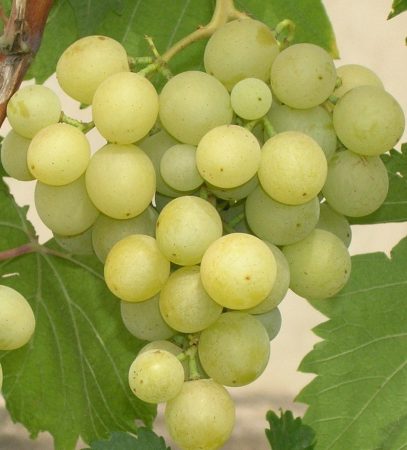 It is positioned as frost-resistant raisins, can withstand minus 34ºC. You should not test, the declared indicators are often lower than what they get in reality. It grows well in short summer regions, ripens quickly (115 days), but to avoid freezing it is recommended to slightly cover
It is positioned as frost-resistant raisins, can withstand minus 34ºC. You should not test, the declared indicators are often lower than what they get in reality. It grows well in short summer regions, ripens quickly (115 days), but to avoid freezing it is recommended to slightly cover
Sweet, seedless (sometimes small rudiments appear), attractive in appearance. Grapes 3-4 g, green with a yellow tint. Few susceptible to infections.
Louise Swanson
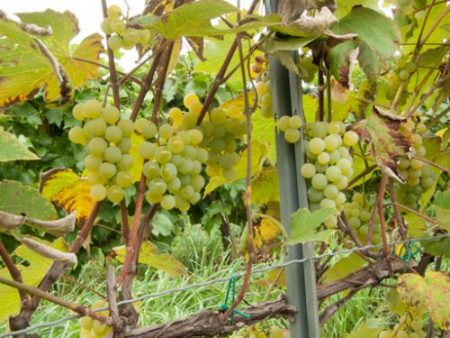 Hybrid of 2001, place of origin - USA. The name was given by breeder E. Swanson in honor of his wife. Grade Advantages:
Hybrid of 2001, place of origin - USA. The name was given by breeder E. Swanson in honor of his wife. Grade Advantages:
- sweet berries (20% sugar);
- easy care;
- ability to withstand cold at minus 35ºC ... 40ºC;
- stable yield.
The vine grows moderately, due to the late budding of the buds, the harvesting dates are slightly shifted to the end of September. He showed himself well when grown in risky farming zones, and does not freeze.
Small brushes, berries on short stalks, rounded. On a greenish skin there is a spring. The taste is good, mainly the fruits go to the production of wines.
Marquette
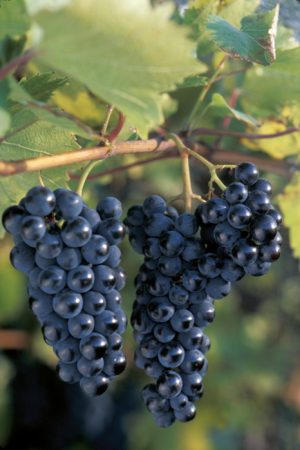 Known in Russia for about 10 years, bred in the north of the USA. Seedlings offer specialized nurseries.
Known in Russia for about 10 years, bred in the north of the USA. Seedlings offer specialized nurseries.
Immunity to diseases is genetically laid, minus -38ºC indicators of air. Gives grones 200-300 grams, loose, with fruits of dark blue color. It has a high sugar content (26%).
During cultivation, it is taken into account that overexposure of berries negatively affects sweets. Unpretentious, the stems need little pruning. Young shoots in the spring shelter from possible return frosts.
Frontignac
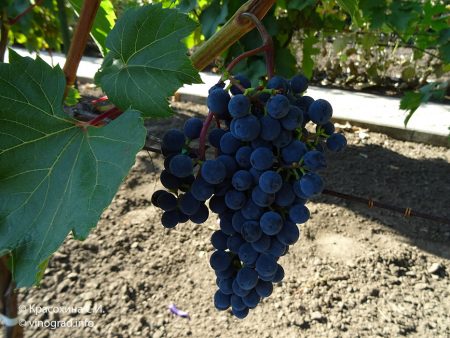 In the US state of Minnesota, work is underway to develop grape hybrid forms that are resistant to sharp drops in temperature. Frontignac is one of the results of the painstaking work of scientists, medium-late, productive, used to make delicious wine.
In the US state of Minnesota, work is underway to develop grape hybrid forms that are resistant to sharp drops in temperature. Frontignac is one of the results of the painstaking work of scientists, medium-late, productive, used to make delicious wine.
It forms a medium density cluster with small round berries. The skin is black; the taste is pleasant. “Minus” Frontignac - a large number of acids (up to 18 g / l), a rapid loss of presentation in mature fruits.
Fruits abundantly after harsh (minus 35ºC) winters; shoots are partially rationed to increase fruit collection.
Adalmina
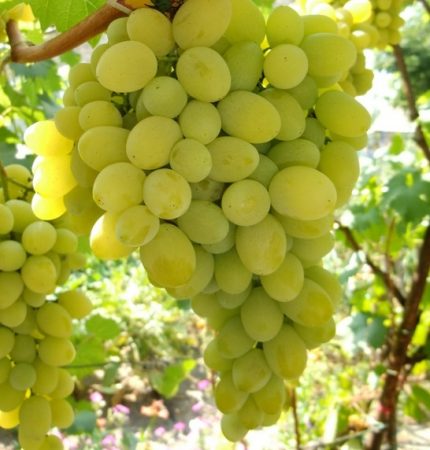 Excellent raw materials for making wine gives Adalmina, bred in the United States. In America, Adalmina grapes are called Golden, they make dessert and table high-quality wine from it.
Excellent raw materials for making wine gives Adalmina, bred in the United States. In America, Adalmina grapes are called Golden, they make dessert and table high-quality wine from it.
Ripens in 115-120 days, grapes are small, amber "sunny" in color. The taste is rich, with floral notes and a little astringency. In Quebec, Minnesota is considered one of the best varieties for winemaking.
Frost resistance is high, winters at minus 35ºC with or without light shelter. Used to design arches, arbors.
Features of the cultivation of non-covering varieties
A note in the description of the grape that the hybrid is non-covering, must be taken into account, but proceed with caution. Even the most persistent species do not show abilities immediately, adaptation to growing conditions is necessary, and the plant gradually gets used to the cold.
Action Scheme:
- in the first two seasons before wintering, the vine is carefully removed from the supports and laid under cover;
- in the third year they experiment with one tall and powerful shoot, leaving it to test frost resistance;
- with a good result in the spring in the fall without shelter leave the entire bush.
Hybrid forms grow quickly, form powerful bushes. Without rationing the shoots, regular pruning, the yield is significantly reduced. A large number of stems inhibits the formation of grones, the berries ripen slowly. Without pinching and removing stepchildren, grapes degenerate, the hybrid loses its unique properties, passing into the category of “simple” species.
Landing in the spring requires special care, when in regions with a harsh climate, the main frosts pass, but light frosts are likely. The vine of frost-resistant varieties does not tolerate thaws, spring drops. An indicator of minus 10ºC can ruin the plantings, although the plants wintered well.
In spring, the shoots are covered with non-woven material.
The northern regions, Siberia and the Urals are territories that are optimally climate-friendly for non-covering hybrids. The plants can withstand cold weather, while in the soil there are no microorganisms and pests dangerous for grapes.
Grape growers use less toxic chemicals for treatments, which are difficult to manage in the south. For feeding, organics are more often used, getting environmentally friendly and safe crops.
Highly resistant non-covering hybrids
Grown in areas with short cool summers, long winters with severe frosts. The ripening period is short, the berry manages to ripen before the cold weather.
The market presents hybrid forms of foreign selection (USA, Hungary), Russian varieties.
Ontario
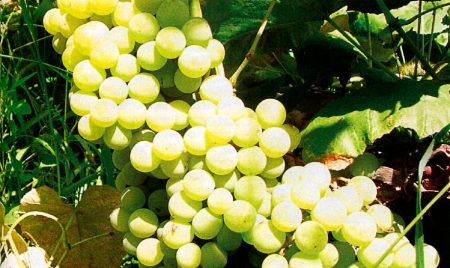 On mid-growth bushes in Ontario, by mid-September, small brushes of whitish berries mature. When fully ripened, the color changes, gaining a golden tint.
On mid-growth bushes in Ontario, by mid-September, small brushes of whitish berries mature. When fully ripened, the color changes, gaining a golden tint.
Fruits weighing 2-3 g, sweet (sugar 18-20%), tasty as dessert, suitable for making wines. Medium disease resistance, therefore prevention is required.
They do not shelter for the winter, protection is necessary only in snowless seasons. Harvested gradually, this is due to the slow ripening of grapes in the grones. The hybrid is not afraid of frost minus 30ºC.
Bianca
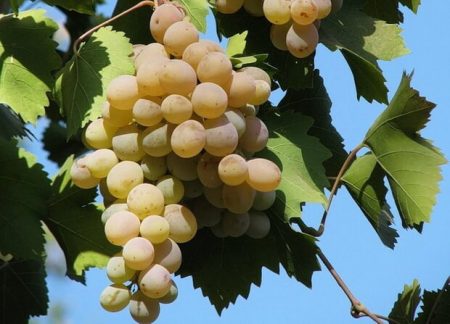 Hungarian variety, withstands cold minus 27ºC, perfectly restored after possible wintering lesions.
Hungarian variety, withstands cold minus 27ºC, perfectly restored after possible wintering lesions.
Included in the group of technical varieties, goes to the production of delicious dessert wines.
Small brushes, slightly dense, with rounded small yellowish berries. The pulp contains a lot of water, juicy, with a sweet taste.
Bianca (Bianca) is appreciated for its simple care, the sweetness of berries (sugar 28%), the presence of bright honey and floral notes in the taste. Indicators of alcoholicity are impressive - 14%, acid - 7%. For a set of sugar experienced growers leave the fruits for overexposure for a couple of weeks. It produces crops in the middle lane, in the Urals.
Riddle of Sharov
 Altai breeders are known for their hard work, and thanks to these people, gardeners have the opportunity to grow exotic cultures for the North in the plots. Since the end of the last century, a hybrid developed by R.F. Sharov - an enthusiast in his field.
Altai breeders are known for their hard work, and thanks to these people, gardeners have the opportunity to grow exotic cultures for the North in the plots. Since the end of the last century, a hybrid developed by R.F. Sharov - an enthusiast in his field.
Sharov’s riddle is known in different regions of the Russian Federation. It is valued for its resistance to minus indicators (-30ºC) of temperature, quick yield of the crop (110 days). The vine is thin, flexible, if necessary shelter (in harsh climates, it is recommended to slightly cover the plantings) does not break.
Branched and friable clusters are formed from dark blue berries. Fruit weight - 3 g, brushes - up to 500 g. First, the berries are slightly acidic, then the taste takes on sweetness, strawberry aroma. From adult bushes 10-12 kg of fruits are harvested.
Be sure to normalize the load on the stems, keep 2-3 brushes on one vine.
Taiga Emerald
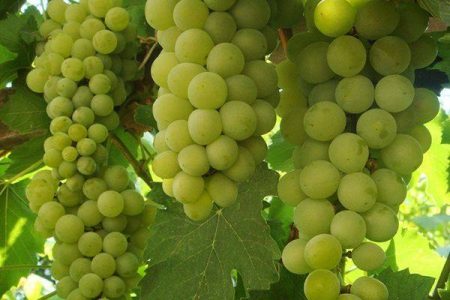 The pale green, almost transparent berries of the species really resemble a valuable mineral. The form, developed in the mid-1950s by breeder N. Tikhonov, quickly spread throughout the regions of Russia.
The pale green, almost transparent berries of the species really resemble a valuable mineral. The form, developed in the mid-1950s by breeder N. Tikhonov, quickly spread throughout the regions of Russia.
Taiga emerald is different:
- neat medium sized bushes;
- high sugar content in berries (20%), acid (11%);
- resistance to adverse factors.
Even in cool summers, the crop is stable, the berries have time to ripen by August. Yields are low, but everything is offset by good taste, frost resistance, simple care of the crop.
Little sick, practically not damaged by pests, does not require shelters during wintering. It is recommended for beginner growers, as even with errors in agricultural technology, there will be no special losses in yield.
Valiant
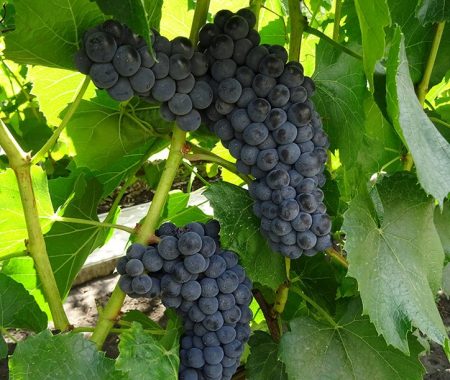 Positioned as one of the hardy hybrids, bred in the United States in South Dakota. Despite the light weight of the brushes and small berries, Valiant is popular as an unpretentious and productive species.
Positioned as one of the hardy hybrids, bred in the United States in South Dakota. Despite the light weight of the brushes and small berries, Valiant is popular as an unpretentious and productive species.
The name ("brave") is fully justified; grapes have successfully shown themselves in regions with harsh climatic conditions.In our country, it is grown in Siberia, in areas of the North-West (Leningrad Region, Karelia).
The sugar content in dark blue berries is 18-24%, the acid values are high - 10g / l. The taste of isabel varieties, wine aroma, notes of strawberries, pineapple, currants are clearly manifested.
Triumph
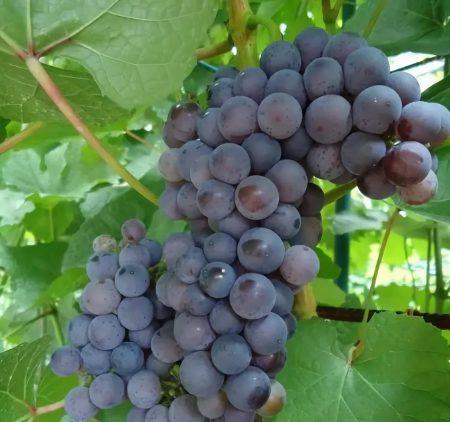 The dream of a beginner winegrower - not requiring adjustment and careful trimming of the Triumph. Harvested at the end of summer, massive storms, up to 1 kg. Advantages:
The dream of a beginner winegrower - not requiring adjustment and careful trimming of the Triumph. Harvested at the end of summer, massive storms, up to 1 kg. Advantages:
- beautiful brushes (the weight of the grones increases with age);
- decent taste, a large amount of sugar in the fruit;
- maintains the lowered temperatures to minus 40ºC;
- quick ripening.
The birthplace of the hybrid is the USA, in many states Triumph is considered the best of the early ripe types of culture. It quickly recovers from damage and is used as the basis for creating hybrid forms of new generations.
Kay gray
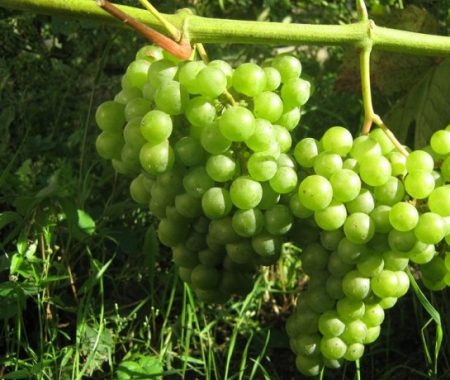 It is called a masterpiece of American selection in the group of hybrids resistant to frost below -35ºC ... -38ºC. Berries, like brushes, are small, amber.
It is called a masterpiece of American selection in the group of hybrids resistant to frost below -35ºC ... -38ºC. Berries, like brushes, are small, amber.
Powerful plants with strong shoots. Harvest ripens early, by early August, the berries are ready for harvest. Taste is average, suitable for winemaking. The scope is the production of wines such as Labruschi (low acidity).
Moore Earley
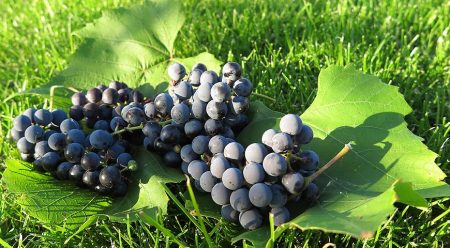 Perfectly wintering in the midland, the species gives yields in difficult weather conditions. The place of selection is the north of the USA, the harvesting dates are early.
Perfectly wintering in the midland, the species gives yields in difficult weather conditions. The place of selection is the north of the USA, the harvesting dates are early.
Peduncles bisexual, replanting pollinators is not required. The average size of the grona is formed, sometimes a wing is present. The structure of the brush is medium density, rounded berries are placed friable.
The pronounced isabial taste, the color of the skin and pulp is ink. There is a subtle strawberry aroma.
Grows on arches, arbors, shelter in the suburbs is not required.
It is recommended 2 weeks before harvesting to cut off part of the leaves around the brushes for better ripening.
Venus
 By mid-September, Venus is ripening in the Moscow Region - seedless grapes of American selection. Harvest raisins give brushes of 200-300 g, with saturated blue berries.
By mid-September, Venus is ripening in the Moscow Region - seedless grapes of American selection. Harvest raisins give brushes of 200-300 g, with saturated blue berries.
The fruits are covered with a strong spring plaque, suitable for transportation, well stored.
Maturing term - 120 days, unpretentious, resistant to infections. Taste is high, sugar - almost 20%. Demanding on the composition of the soil, it works better on sandstone. In the Central region of the Russian Federation, winters without shelter; in the more northern regions, it is recommended to bend down and protect shoots from above with obligatory lateral vents.
The most frost-resistant for arbors and arches
The culture refers to lianoid plants, when growing requires support. Special trellises or small architectural structures in the garden (arches, arbors, columns) are used.
In the south, all types of grapes with the longest vine length are suitable for decoration. In cold climates, frost-resistant hybrids are selected.
Lydia
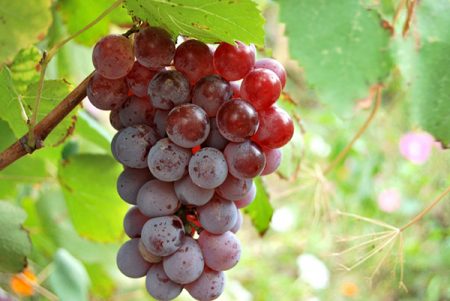 It is widespread, unpretentious, with a high percentage of yield. "Clone" of the famous Isabella, but the berries are pink in color with a dull admixture of a purple hue.
It is widespread, unpretentious, with a high percentage of yield. "Clone" of the famous Isabella, but the berries are pink in color with a dull admixture of a purple hue.
The taste is wine, with a characteristic aroma of strawberries.
Grones are small, up to 100 grams, conical, with several branches. The structure is loose.
It is steady against frosts, responds to top dressing with organic matter. Harvest for a long time does not lose its presentation, tolerates transportation well.
Aleshenkin
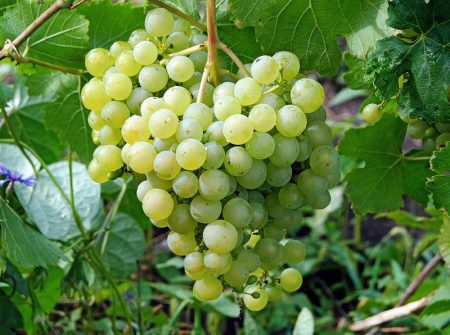 An easy-going, easy-to-grow grape is recommended for beginner gardeners. The taste qualities of ripe berries are high, the ripening time is early.
An easy-going, easy-to-grow grape is recommended for beginner gardeners. The taste qualities of ripe berries are high, the ripening time is early.
In regions with a harsh climate, it is still better to cover for wintering; in the middle lane it tolerates winter easily. Shows a good yield even in adverse summers, 8-10 kg. In the south, up to 20-25 kg are removed from the bush.
Powerful brushes, up to 1.5-2 kg. The berries are beautiful, pale green in color with mother of pearl, on top - spring plaque. About 40-50% of the fruits are seedless.
Brushes normalize, otherwise peas cannot be avoided.
Tukai
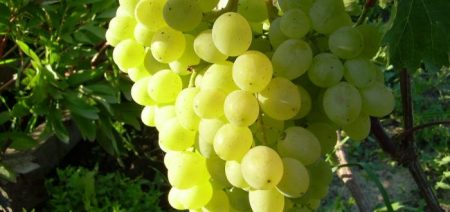 The view withstands cold up to minus 23ºC, is characterized by strong vine growth, and needs strong supports. Suitable for decoration of arbors, arches.
The view withstands cold up to minus 23ºC, is characterized by strong vine growth, and needs strong supports. Suitable for decoration of arbors, arches.
It bears fruit well in the south, in the middle lane, and produces crops in Siberia and the Urals. It is recommended that when forecasting for the coming harsh winter, shoot shoots from the arches are still in order to prevent freezing.
Grapes ripen after 105 days, in the southern regions begin harvesting in late July. In the Northwest, in the suburbs, fruits are harvested in late August or the first half of September.
Berries differ in juiciness, excellent taste. The peel is first greenish-white, then with a crimson “blush”. Tukai is a lying grape, the berries lie without loss of taste and presentation for 3-4 months.
Isabel
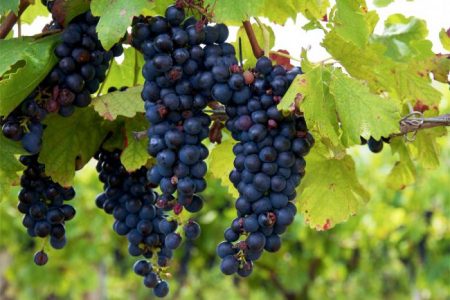 Bred in the USA, the variety has spread to many countries, including in the USSR. Grown everywhere, despite the late harvest (in October) cultivated in the middle lane, Moscow region.
Bred in the USA, the variety has spread to many countries, including in the USSR. Grown everywhere, despite the late harvest (in October) cultivated in the middle lane, Moscow region.
The purpose is universal, berries are good as raw materials for making wine, juices, and for other blanks. Loose brushes weigh 230-250 grams, balls-berries of violet color. There is a strong smoky coating on the skin.
Sugar - 18%, which is enough to get a tasty wine. When eating, the characteristic taste of garden strawberries is felt.
When sheltering for the winter, it can withstand air temperatures down to -35ºC; without shelters, it hibernates at -26ºC. It is characterized by rapid recovery after spring frosts.
Pink pink sidlis
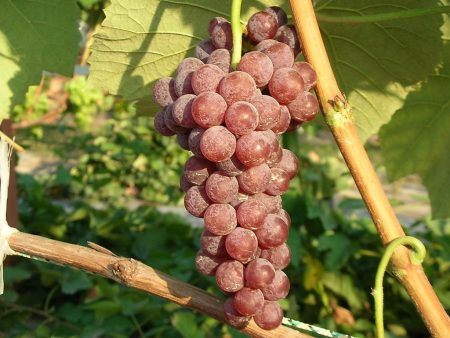 American hybrid obtained in Arkansas. Characteristics are impressive:
American hybrid obtained in Arkansas. Characteristics are impressive:
- high sugar content (25%);
- frost resistance (-28ºC);
- excellent presentation;
- stable yield.
Pink berries form strong brushes, weight 350-400 g. There are no seeds or small rudiments are present. Matures after 110 days, which is suitable for areas with a short summer.
Disadvantages are low resistance to a number of diseases and cracking at high humidity.
In addition to the above, the following varieties are recommended for decoration and at the same time harvesting:
- Concord
- Bars;
- Hassan.
Hybrid forms Amethystovy, Marinovsky, Olenevsky (with black berries), bred by A. I. Potapenko, proved to be quite good. Arbor grapes formed by a special technology, using a fan cut or a vertical cordon.
Reviews
Alexandra, Moscow Region
Blue northern grapes were grown by my mother in the Leningrad region. We moved to the suburbs, took a few seedlings for their garden. While young, but have already shown themselves very well. The first berries were removed, so we will wait for large yields. In the Leningrad region, the experience of growing more. There, this variety grows excellently, yielding fruit already at the end of summer. The bushes are strong, with large and very dense clusters. It can winter on trellises, but we still shelter and throw it with snow. From 2 square meters were removed 4 large wicker baskets of berries.
Yuri, Penza
Planted seedlings of Jupiter about 8 years ago. Took in Ukraine. Some of the bushes for testing wintered without shelter, while others covered. There were cold frosty days, up to minus 30, but there were enough kidneys to form. A total of 40 bushes are now growing, everyone is good. Minus - medium growth, I plan to vaccinate in Moldova. I really like all the homemade taste, like strawberries. There is no trace of labrusca.
The emergence of culture hybrids with high winter hardiness indicators makes it possible to grow “sunny berry” in areas with difficult climatic conditions. Gardeners of the northern regions choose from a wide range of varieties, not content with only technical grapes for winemaking.

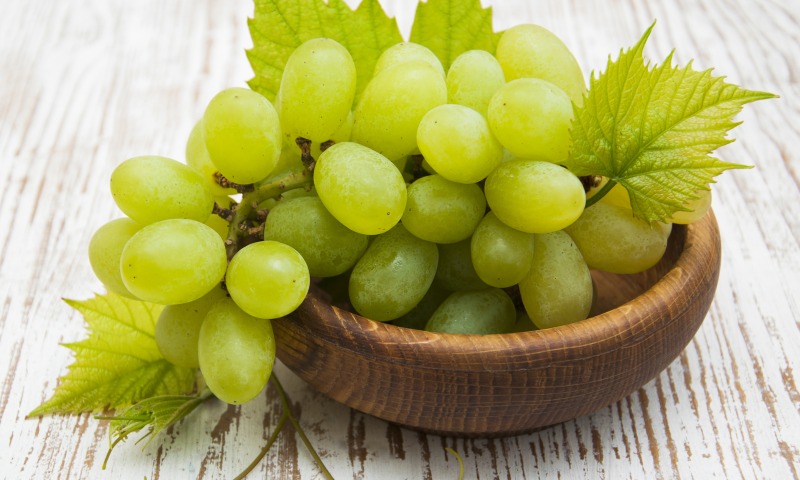



 Non-covering winter-hardy grape varieties for Moscow region
Non-covering winter-hardy grape varieties for Moscow region How to keep the vine in winter
How to keep the vine in winter When can I transfer grapes to another place in the fall
When can I transfer grapes to another place in the fall How to cover and prepare grapes for the winter in the suburbs
How to cover and prepare grapes for the winter in the suburbs
Misha
The main requirements for country viticulture are reduced to the ability to grow a grape culture without the use of chemistry. That is, they must be varieties sufficiently resistant to diseases and pests, productive, frost-resistant, characterized by high taste qualities of berries. Most often, at home, table or universal grapes are grown, which can be used fresh for preparing winter stocks.